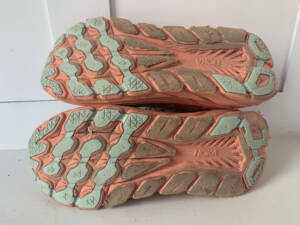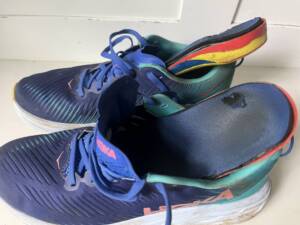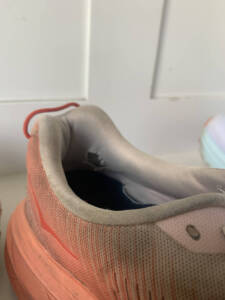Last week I started getting some knee pain which was odd for me. I looked at my running shoes and realized I likely needed a new pair. Sure enough, after I replaced my Hokas, my knee felt better—almost instantly. Which then begs the question: when should you replace your running shoes?
Related: Hoka Rincon 3 Review
Some people religiously track their running shoes’ mileage. I remember my dad having calendars hanging upon his closet walls where he wrote his mileage with sharpies, totaling his shoe mileage at the end of each week.

I take a more laissez-faire approach to track my running shoes’ mileage: when my legs start to feel dead and less springy, that’s when I buy new running shoes.
However, there are better ways that fall in between these two tactics to figure out when to replace your running shoes.
In this article, I’m going to review:
- why you need to replace your running shoes,
- how often you should replace your running shoes, and
- signs you need to replace your running shoes (and much more!).
So, let’s roll!
Why should you replace your running shoes?

Shoes break down over time and so the more miles on them, the less cushion and support they give you. If you don’t replace your shoes, you risk a running injury.
Related: How to Prevent Common Running Injuries
This isn’t just something I’ve learned from experience. A research study found that as the materials of running shoes degrade with impact, a runner’s posture and gait change. This running form change can then lead to injury.
Related: How to Fix Your Running Form
Also, running in old running shoes just doesn’t feel good. Your legs feel less springy and each time you lift up your foot feels harder. This is because the foam in your shoes at the mid-sole absorbs the shock each time your foot strikes, and as a result, warps and flattens. You also lose the tread of your shoes as your foot hits the ground.
How long do running shoes typically last?
The lifespan of a running shoe is defined by miles rather than time, and most running shoes last between 300 and 500 miles. So, if you run 20 miles a week, you should get new shoes around every four to six months.
There are several factors that impact how long a running shoe lasts.
- Mileage: The more you run, the faster your running shoes will wear down. Mileage is the biggest factor affecting when you should replace your running shoes.
- Type of shoe: A lightweight minimalist shoe may only last 250 to 300 miles. A more cushioned shoe with a carbon fiber plate (aka a super shoe like the Nike Alphafly Next %s) may last even less than that.
- Runner’s body type: If you are a heavier runner, your shoes are going to wear down faster than a lighter runner. This is because each footstrike is made with a stronger impact, degrading the material more with each step.
- Runner’s biomechanics: Likewise, the way you run will impact how long your shoes last. If your feet strike the ground hard rather than light, short turnover, your running shoes will wear out faster. Also, if you overpronate, your shoes will wear out on the heels, and possibly inside the heel as well, faster.
- Running surface: If you run a lot on hard concrete and asphalt versus on soft dirt paths or trails, your shoes will not last as long. The harder and rougher the surface, the faster your running shoes will degrade.
- Environment: Running in the heat on hot surfaces or in the rain will take its toll on the materials of your running shoes faster than running in cooler, dry temperatures.
Note: The cost of the shoes does not impact how long the shoe will last.
Do super shoes last as long as regular running shoes?
Super shoes like the Nike Alphafly Next %s may be pricey ($275!) and make you faster but they don’t last as long as regular running shoes. In general, the softer and lighter the shoe, the quicker you will need to replace your running shoes.
Therefore, racing shoes tend to not last as long as regular trainers.
(Sidenote: I wore my first pair of Nike Vaporflies until a chunk of the heel fell off while running! I still wear them when walking because I love the bouncy feel in my legs.)
How many miles should you put on your running shoes?
On average, running shoes last between 300 and 500 miles. Track your mileage using a running app like Strava, your GPS watch, a calendar, or by looking at the wear on your soles.
How do I know if my running shoes are worn out?
The best way to tell if you should replace your running shoes is a worn-out sole. If the tread on the bottom of your shoe is worn smooth, then it is likely time to get a new shoe.
Other areas of wear and tear such as worn-out heels and holes inside or outside the shoes are also signs that you need new running shoes.
Do running shoes degrade over time?

Even if you do not wear your running shoes, they will degrade over time, beginning at six to twelve months from when you bought them. After about five to six years, your unworn running shoes will not be fit for running.
This is because the moisture in the air causes the materials to break down and become brittle over time.
The best way to preserve your unworn running shoes is in the shoebox.
How long should you break in running shoes?
Some running shoes can take a couple of weeks to break in.
- Begin by wearing them as you walk around the house or running errands.
- Do a couple of short runs in them.
- You can also soften and promote flexion on the sole by using a hairdryer on the insides before you wear them. This will obviously shorten the lifespan of your shoes.
If your shoes feel uncomfortable or your feet hurt, you got the wrong shoes! Most places will take them back if you’ve only put a few miles on them.
It’s always a good idea to check with a store or site’s return policy before buying shoes. Most online retailers will take back slightly worn shoes. Local running stores have different policies, so ask!
What should I do with my worn running shoes?

A lot of running shoe companies like Nike will take your worn running shoes back and recycle them. You can also donate them to a charity such as Soles4Souls. Many local running companies also take worn running shoes and donate them to those in need or to a recycler.
The EPA reports that the U.S. create 13 million tons of clothing and footwear waste in 2018. So, don’t toss your shoes. Do your part and let them live a longer life.
How many miles do running shoes last on a treadmill?
Running shoes may last a bit longer on the treadmill because they are exposed to less resistance and elements. If you run mostly on the treadmill, you can expect to get between 500 and 650 miles on your shoes before you need to replace them.
However, track your mileage and look at your soles regularly.
Related: How Many Miles Should You Run in a Day
Can you make running shoes last longer?
There are several ways to make your running shoes last longer:
- Rotate your shoes. The best way to make running shoes last longer is to have several pairs of running shoes and rotate them. Running in more than one pair of running shoes also helps prevent overuse injuries as it slightly alters your gait pattern. By the way, it is helpful to have a new pair rotating in as you wear your old pair for a couple more weeks.
- Wear your shoes only for running. Keep the miles only to the ones that count in your training. Also, keep your expensive racing shoes just for racing.
- Take care of your shoes. Untie them when you are done. Wipe them clean or throw them in a gentle cycle with a towel. Stuff them with newspaper to dry whenever wet. Store them inside.
- Run on soft surfaces. If you can keep the majority of your miles to soft dirt paths or grass, your shoes will last longer (your legs may, too!).
Related: 9 Steps to Return to Running from Injury
5 Signs You Need New Running Shoes

There are several signs that you need to upgrade your running shoes. Be on the lookout for these signs:
- Your legs feel dead. If you have less spring in your step when you’re running, take a look at your shoes. Have you been wearing them for several months and hundreds of miles? Are your soles worn down? Then it is time to get a new pair of running shoes!
- You have new aches and pains. Similarly, if you are having niggles or injuries, your shoes could be the culprit. If you don’t usually have knee pain and all of a sudden your knees feel stiff and achy, it could be time for some new shoes!
- You feel very tired after easy runs. If your heart rate is high or you feel exhausted after an easy run, there is a chance your shoes could be to blame. Your body could be working harder to get your feet off the ground because your shoes are flat.
- Your treads are worn down or have holes. The best way to tell if you need new shoes is to look at the treads (much like you would for a tire!). If they are worn down, then it is time for new shoes. Also, if you have any holes in your shoes including the heel on the inside of your shoe or the toes where your toenails pop out. (That could also be a sign you need to go up a half size in your shoe).
- You have blisters. If you suddenly start getting blisters, black toenails, or any other sign of friction, it could mean the shape of your shoe has warped and it’s time for some new ones!
You work too hard to let old running shoes stand in the way of your success. Take care of them and take care of yourself!
And if you want more support with your running goals, check out my run coaching services!
.
